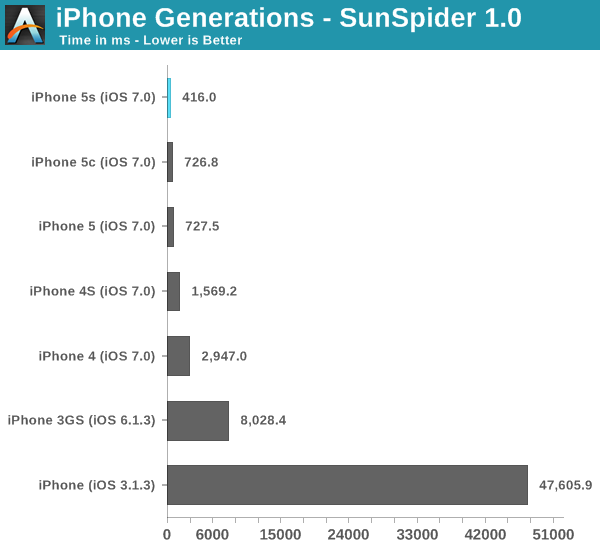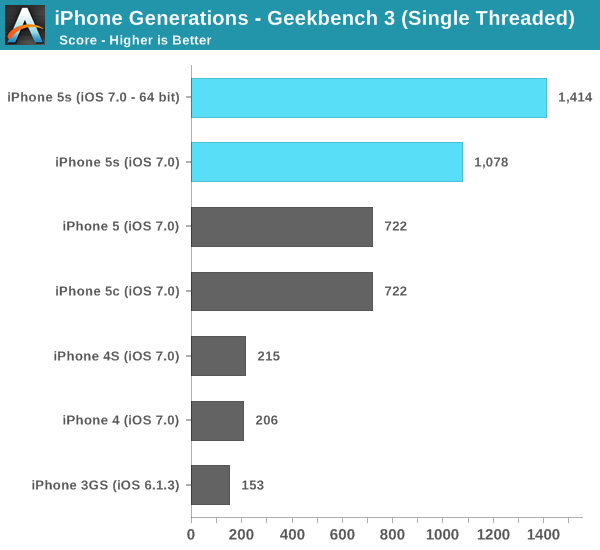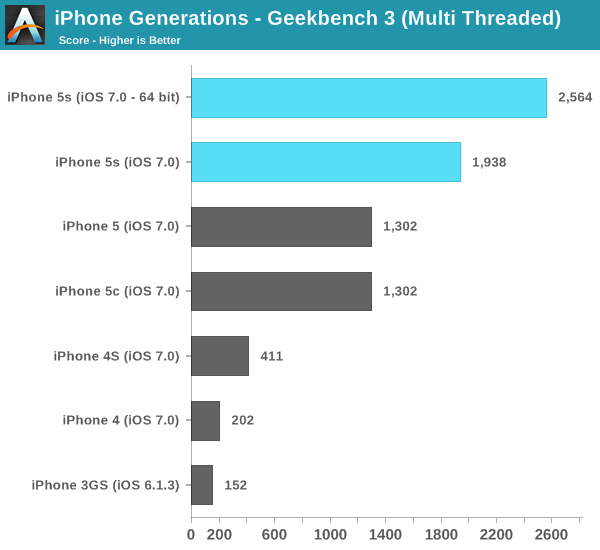The iPhone 5s Review
by Anand Lal Shimpi on September 17, 2013 9:01 PM EST- Posted in
- Smartphones
- Apple
- Mobile
- iPhone
- iPhone 5S
iPhone Performance Across Generations

Performance improved by a factor of 100x compared to the original iPhone. You can cut that in half if the iPhone could run iOS 4. Needless to say, Apple's CPU performance estimates aren't unreasonable. We've come a long way since the days when ARM11 cores were good enough.
Even compared to a relatively modern phone like the iPhone 4, the jump to a 5s is huge. The gap isn't quite at the level of an order of magnitude, but it's quickly approaching it. Using the single core iPhone 4 under iOS 7 just feels incredibly slow. Starting with the 4S things get a lot better, but I'd say the iPhone 4 is at the point now where it's starting to feel too slow even for normal consumers (at least with iOS 7 installed).

Browsermark 2.0 gives us a good indication of less CPU bound performance gains. Here we see over a 5x increase in performance compared to the original iPhone, and an 83% increase compared to the iPhone 4.
I wanted to have a closer look at raw CPU performance so I turned to Geekbench 3. Unfortunately Geekbench 3 won't run on anything older than iOS 6, so the original iPhone bows out of this test.

Single threaded performance scaled by roughly 9x from the 3GS to the iPhone 5s. The improvement since the iPhone 4/4S days is around 6.5x. Single threaded performance often influences snappiness and UI speed/feel, so it's definitely an important vector to scale across.

Take into account multithreaded performance and the increase over the 3GS is even bigger, almost 17x now.
The only 3D test I could get to reliably run across all of the platforms (outside the original iPhone) was Basemark X. Again I had issues getting Basemark X running in offscreen mode on iOS 7 so all of the tests here are run at each device's native resolution. In the case of the 3GS to 4 transition, that means a performance regression as the 3GS had a much lower display resolution to deal with.

Apple has scaled GPU performance pretty much in line with CPU performance over the years. The 5s scores 15x the frame rate of the iPhone 4, at a higher resolution too.
iPhone 5s vs. Bay Trail
I couldn't help but run Intel's current favorite mobile benchmark on the iPhone 5s. WebXPRT by Principled Technologies is a collection of browser based benchmarks that use HTML5 and js to simulate a number of workloads (photo editing, face detection, stocks dashboard and offline notes).

Granted we're comparing across platforms/browsers here, but the 5s as a platform does extremely well in Intel's favorite benchmark. The 5c by comparison performs a lot more like what we'd expect from a smartphone platform. The iPhone 5s is in a league of its own here. While I don't expect performance equalling the Atom Z3770 across the board, the fact that Apple is getting this close (with two fewer cores at that) is a testament to the work done in Cupertino.
At its launch event Apple claimed the A7 offered desktop class CPU performance. If it really is performance competitive with Bay Trail, I think that statement is a fair one to make. We're not talking about Haswell or even Ivy Bridge levels of desktop performance, but rather something close to mobile Core 2 Duo class. I've broken down the subtests in the table below:
| WebXPRT Performance (time in ms, lower is better) | ||||||
| Chrome/Mobile Safari | Photo Effects | Face Detection | Stocks | Offline Notes | ||
| Apple iPhone 5s (Apple A7 1.3GHz) | 878.9 ms | 1831.4 ms | 436.1 ms | 604.6 ms | ||
| Intel Bay Trail FFRD (Atom Z3770 1.46GHz) | 693.5 ms | 1557.0 ms | 542.9 ms | 737.3 ms | ||
| AMD A4-5000 (1.5GHz) | 411.2 ms | 2349.5 ms | 719.1 ms | 880.7 ms | ||
| Apple iPhone 5c (Apple A6 1.3GHz) | 1987.6 ms | 4119.6 ms | 763.6 ms | 1747.6 ms | ||
It's not a clean sweep for the iPhone 5s, but keep in mind that we are comparing to the best AMD and Intel have to offer in this space. I suspect part of why this is close is because both of those companies have been holding back a bit (there's no rush to build the fastest low margin parts), but it doesn't change reality.










464 Comments
View All Comments
ddriver - Wednesday, September 18, 2013 - link
I mean, only a true apple fanboy is capable of disregarding all that technical argumentation because of the mention of the term "apple fanboys". A drowning man will hold onto a straw :)akdj - Thursday, September 19, 2013 - link
You consider your comment 'technical argumentation'? It's not....it's your 'opinion'. I think you can rest assured Anand's site is geared much more to those of us interested in technology and less interested in being a 'fanboy'. In fact....so far reading through the comments, you're the first to bring that silly cliché up, "Fan Boy".A drowning man will hold on to anything to help save himself :)
Wilco1 - Wednesday, September 18, 2013 - link
Good comment - I'm equally unimpressed by the comparison of a real phone with a Bay Trail tablet development board which has significantly higher TDP. And then calling it a win for Bay Trail based on a few rubbish JS benchmarks is even more ridiculous. These are not real CPU benchmarks but all about software optimization and tuning for the benchmark.Single threaded Geekbench 3 results show the A7 outperforming the 2.4GHz Bay Trail by 45%. That's despite the A7 running at only 54% of the frequency of Bay Trail! In short, A7 is 2.7 times faster than BT and on par/better than HasWell IPC...
tech4real - Wednesday, September 18, 2013 - link
not trying to dismiss A7's cpu core, it's an amazing silicon and significantly steps up against A6, but is there a possibility that the geekbench3 is unfit to gauge average cross-ISA cross-OS cpu performance... To me, the likelihood of this is pretty high.Wilco1 - Wednesday, September 18, 2013 - link
Comparing different ISAs does indeed introduce inaccuracies due to compilers not being equal. Cross OS is less problematic as long as the benchmark doesn't use the OS a lot.It's a good idea to keep this in mind, but unfortunately there is little one can do about it. And other CPU benchmarks are not any better either, if you used SPEC then performance differences across different compilers are far larger than Geekbench (even on the same CPU the difference between 2 compilers can be 50%)...
Dooderoo - Wednesday, September 18, 2013 - link
"The AES and SHA1 gains are a direct result of the new cryptographic instructions that are a part of ARMv8. The AES test in particular shows nearly an order of magnitude performance improvement".Your comment: "in reality the encryption workloads are handled in a fundamentally different way in the two modes [...] a mixed bad into one falsely advertising performance gains attributed to 64bit execution and not to the hardware implementations as it should"
Maybe actually read the article?
"The FP chart also shows no miracles, wider SIMD units result in almost 2x the score in few tests, nothing much in the rest"
Exclude those test and you're still looking at 30% improvement. 30% increase in performance from a recompile counts at "nothing much" in what world?
ddriver - Wednesday, September 18, 2013 - link
My point was encryption results should not have been included in the chart and presented as "benefits of 64bit execution mode" because they aren't.Also those 30% can easily be attributed to other incremental upgrades to the chip, like faster memory subsystem, better prefetchers and whatnot. Not necessarily 64bit execution, I've been using HPC software for years and despite the fact x64 came with double the registers, I did not experience any significant increase in the workloads I use daily - 3D rendering, audio and video processing and multiphysics simulations. The sole benefit of 64bit I've seen professionally is due to the extra ram I can put into the machine, making tasks which require a lot of ram WAY FASTER, sometimes 10s even 100s times faster because of the avoided swapping.
Furthermore, I will no longer address technically unsubstantiated comments, in order to avoid spamming all over the comment space.
Dooderoo - Wednesday, September 18, 2013 - link
"Furthermore, I will no longer address technically unsubstantiated comments, in order to avoid spamming all over the comment space."Man, you give up too easily.
Encryption results are exactly that: "benefits of 64bit execution mode". Why? 32-bit A32 doesn't have the instructions, 64-bit A64 does. Clear and obvious benefit.
"30% can easily be attributed to other incremental upgrades to the chip". Wouldn't the 32-bit version benefit from those as well?
I'm beginning to think you don't understand that those results are both from the A7 SOC, once run with A32 and once with A64.
ddriver - Wednesday, September 18, 2013 - link
""30% can easily be attributed to other incremental upgrades to the chip". Wouldn't the 32-bit version benefit from those as well?"This may be correct. Unless I am overlooking execution mode details, of which I am not aware, and I expect neither are you, unless you are an engineer who has worked on the A7 chip. I don't think that data is available yet to comment on it in detail.
But you are not correct about encryption results, because it is a matter of extra hardware implementation. It is like comparing software rendering to hardware rendering, a CPU with hardware implementation of graphics will be immensely faster at a graphics workload, even if it is the same speed as the one that runs graphics in software. If anything, the architecture upgrades of the A7 chip can at best result in 2x peak theoretical performance improvement, while the AES test shows 8+x improvement. This is because the performance boost is not due to 64 bit mode execution, but due to the extra hardware implementation that is exclusively available in that mode.
Dooderoo - Wednesday, September 18, 2013 - link
"I don't think that data is available yet to comment on it in detail."Yet you're ok with calling the article "cunningly deceitful"? Weird.